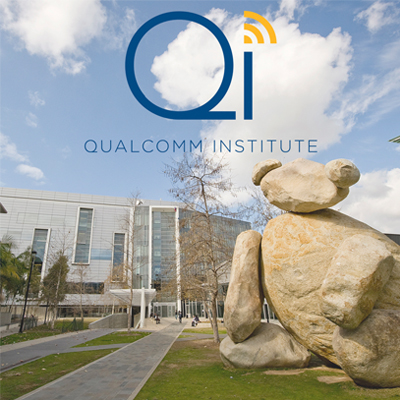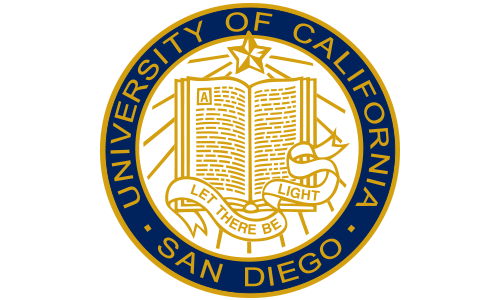Connecting brilliant minds, producing tomorrow’s inventions
When bright individuals from different backgrounds, skills, and disciplines are free to explore and learn from each other, magic starts to happen and concepts turn into reality. Case in point: the Qualcomm Institute at UC San Diego, which brings together the strengths of 350 faculty and senior researchers who are free to collaborate and interact in ways that were previously unthinkable because of the traditional silos of academic departments. The institute, created in 2000, has forged new ways to undertake research on the university campus, allowing researchers and students from widely varying fields to occupy neighboring desks, offices and research neighborhoods. The ensuing interactions and chance encounters have produced long-term research alliances bringing together artists and physicists, electrical engineers and musicians, archaeologists and computer scientists, and many more unlikely and serendipitous collaborations.
Under Director Ramesh Rao, a professor of electrical and computer engineering at UC San Diego, the Qualcomm Institute has fostered a multidisciplinary environment where researchers and students alike are encouraged to think freely, collaborate closely, and overcome obstacles to succeed. “A strange, mysteriously fascinating place,” is how he explains it. “Ever diffuse and all-encompassing, the Qualcomm Institute cultivates a free-spirit that places interdisciplinary research at the heart of its vision, where people can deepen their ‘love affair’ with their interests and passions, by combining partially incomplete efforts to complete a single vision,” says Rao. “They can develop theory into practice and test new solutions for real-life applications. Alongside the “structured” public university that focuses on research and education, the Qualcomm Institute provides an “unstructured” outlet for accelerating results and increasing product development.”
Current areas of research include these four primary applications:
- Culture: Imagine peeling back the layers of a Leonardo da Vinci painting, uncovering its depths and its secrets -- or seeing beyond the human skin into its skeleton by simply pressing into or rubbing against the hyper-touch screen. This highly interactive, educational hyper-touch visualization table is one of the many ways that Qualcomm Institute scientists and engineers are expanding and enriching culture by merging digital arts with science and engineering. With the rise of the Internet, digital media, 3D cinema, and social networking, culture, the way we experience and interact with the world around us is rapidly evolving, and technological advancements are enabling human expression beyond the physical level and propelling it into virtual reality. Pioneering physical/virtual interaction and enlarging its spheres of influence in the arts, humanities, and education, the Qualcomm Institute is establishing digital culture as a critical marker of economic growth in California and nationwide. The institute’s labs and research centers contribute to digital cinema, immersive telepresence; gaming and game culture; machine improvisation; embodied interaction; distributed and participatory performing arts; digital art history; ethnography; archaeology and other areas.
- Energy: University laboratories are focused on ways to improve energy consumption, and to reduce energy’s carbon footprint as well as its cost. With strong recognition in energy and water efficiency, reducing waste streams, and utilizing renewable energy sources, The UC San Diego and UC Irvine divisions of Calit2 are exploring the use of novel materials, new technologies and data-driven control systems for various energy applications on the grounds of their university campuses. Uniquely functioning as “mini-cities,” university campuses are equipped with their own buildings, facilities, transportation, hospitals, and residential population and thus serve as ideal models for experimentation. Focusing on reducing the energy intensity of campus IT and telecom equipment; improving energy efficiency through smart buildings and intelligent transportation; and reducing travel by using virtual/physical collaboration systems.
- Environment: California has experienced wildfires, earthquakes, pollution, and drought. While the emergency-response forces in California are focusing on reacting to each individual natural occurrence, researchers at Calit2 in San Diego and Irvine are combining efforts to catapult digital transformations of monitoring and modeling the environment to tackle this challenge. By creating realistic digital “mirror worlds” -- dynamic representations of our environment -- researchers hope to facilitate planning and preparing the government and the public for future outbreaks of natural disturbances.
- Health: Researchers are taking innovative approaches to improve both individual and population health by developing digital solutions that can radically change the way a disease is diagnosed, treated, and prevented. By creating digitized sources and sensors for collecting biomedical data and monitoring physiological behaviors, researchers hope to provide personalized, efficient plans that can give feedback on the effects of diet and exercise as well as further revolutionize fundamental research in biomedicine and neuroscience.
Bio
Calit2’s Qualcomm Institute is taking ideas beyond theory into practice, accelerating innovation and shortening the time between product development and job creation. Where the university traditionally has focused on education and research, the institute (and its sister division at UC Irvine) extends that focus to include development and deployment of prototype infrastructure for testing new solutions in a real-world context.
The Qualcomm Institute is in a unique position to be able to connect people across a broad range of research and development areas. The institute focuses on topics spanning informational technology, network architecture, wireless communications, and signal processing, but it is much more than just an engineering organization, and those “unconventional methods” have underscored the serendipity of researchers from varying fields becoming collaborators after finding themselves as neighbors in Atkinson Hall, the institute’s headquarters building.
Ultimately, the institute frequently finds itself in demand to help other departments on campus to use technology in a new way. Case in point: one of the functions of the Vice Chancellor’s Office is taking care of research mice on campus, and the high costs of the water, food and “dorms” that cost 15 cents per mouse per night in UCSD labs. Dr. Rao brought together the animal welfare officials with a young computer scientist who was an expert in computer vision. The result: creation of a modern mouse dorm that could be monitored 24/7 with cameras, which could in turn track the movements of mice to determine their health or visible reactions to environmental conditions. The team was able to create a system that facilitated viewing and stabilized animal welfare at a lower cost. To this day, the Qualcomm Institute continues to undertake projects with strong real-life implications, bringing scientists of many fields together.
The Qualcomm Institute represents an experiment in inventing the university research environment of the future to continue to fuel innovation in the global economy. It:
• Builds horizontal links among departments to foster multidisciplinary studies
• Creates research teams consisting of members who can be located anywhere because of the Internet
• Supports involvement by faculty, students, industry, government, and community partners
• Enables prototyping in "living laboratories"
• Provides technical professionals as the bridge between academia and industry
Featured Researchers:
Sheldon Brown
Shaochen Chen
Thomas DeFanti
Mark Ellisman
Sadik Esener
Terry Gaasterland
Hari Garudadri
Tara Javidi
Ryan Kastner
Falko Kuester
Gert Lanckriet
Thomas Levy
Albert Lin
Truong Nguyen
Kevin Patrick
Ramesh Rao
Stefan Savage
Larry Smarr
Joseph Wang
Liangfang Zhang
In the News
Publications
Videos
Awards
Lei Liang
Qualcomm Institute Composer in Residence Shortlisted for Pulitzer Prize
YY Zhou
Qualcomm Endowed Chair Elected IEEE Fellow
Ramesh Rao
Distinguished Alumnus Award 2008, National Institute of Technology (NITT), Tiruchirappalli (India)
Gabriel Rebeiz
2014 IEEE Daniel E. Noble Award for Emerging Technologies
Sheldon Brown
New Media Artist Named to MacArthur Foundation Endowed Chair


